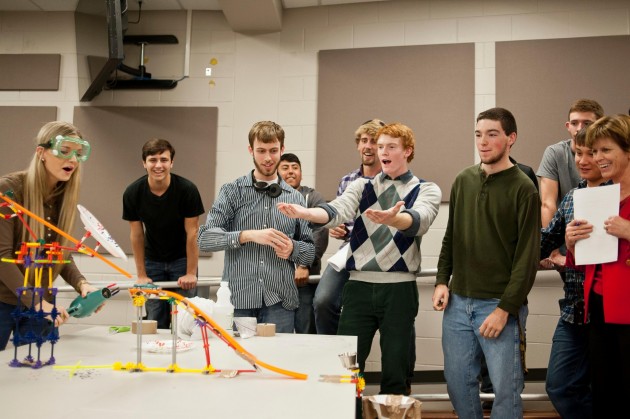
The marble shot off the mousetrap, flying across the room and barely missing a chemical engineering student who had moved out of the way seconds earlier.
The accidentally launched marble was part of a Rube Goldberg machine designed by a team of freshmen chemical engineering students at Tech. The marble was supposed to fly across the room after a paper plate fell from the weight of crayons melted by a hairdryer. The plate would then nudge a toy car down a ramp to hit and knock over a cup of vinegar, which would flow through a funnel and react with baking soda to melt ice. The water was supposed to soak a sponge, and that weight would flip the sponge and hit a toy tire that would fall and spring the mouse trap. Then the marble was supposed to go flying.
But none of it worked. “Engineers love to build,” Holly Stretz, chemical engineering professor, said “Real-world problem solving starts by recognizing that the things you have already experienced in life can be useful for some new function, and engineering and science teaches you to look at the world around you in whole new ways.”
Rube Goldberg machines are elaborate devices that use a chain reaction of events to complete a simple task. Popular in cartoons, they are uncommon in real life. Teams of freshmen worked all semester to design them.
To build the machines, students used sets of Kinex, fishing wire, toilet paper rolls, shoeboxes, balloons, plastic bottles and in one case, a miniature steam engine built of copper wire and half a soda can.
Each design had to incorporate five core elements of chemical engineering students have to take: mass transfer, heat transfer, thermodynamics, fluid mechanics and reaction kinetics. Each team had to ask for help and advice from advanced chemical engineering students or faculty to design their machines.
“The whole idea is to keep them enrolled and engaged in their studies,” Stretz said. “We want to build connections between them and the university, them and older students, them and their classmates and them and the College of Engineering.”
Some students went beyond asking other chemical engineering students for help. Several went to Tech’s chemistry department to ask for permission to use more dangerous chemicals for the reaction kinetics component of the machine. Their appeals were denied, and each of the teams chose to mix vinegar and baking soda, which creates carbon dioxide gas for moving other elements in the design.
“Once they know a bit more, they can use more adventurous chemical reactions,” Stretz said. “The reality is that they are going to be making decisions at chemical plants so they will be using very energetic chemicals eventually. We need them to know how to handle all chemicals safely.”
Extra points were given for the use of biodegradable or recycled materials and for creativity in team names and design. Each group had to give a presentation about their project earlier in the semester and completed a safety review.
Though not one of the six machines in the class period worked all the way through, every student in the class was smiling and laughing throughout the period, which ran well over the standard class time as the teams set up and explained their machines.
“I think this is the best thing ever,” said freshman Jonathan Poore. “It got my foot in the door about chemical engineering and what my classes will be like.”


